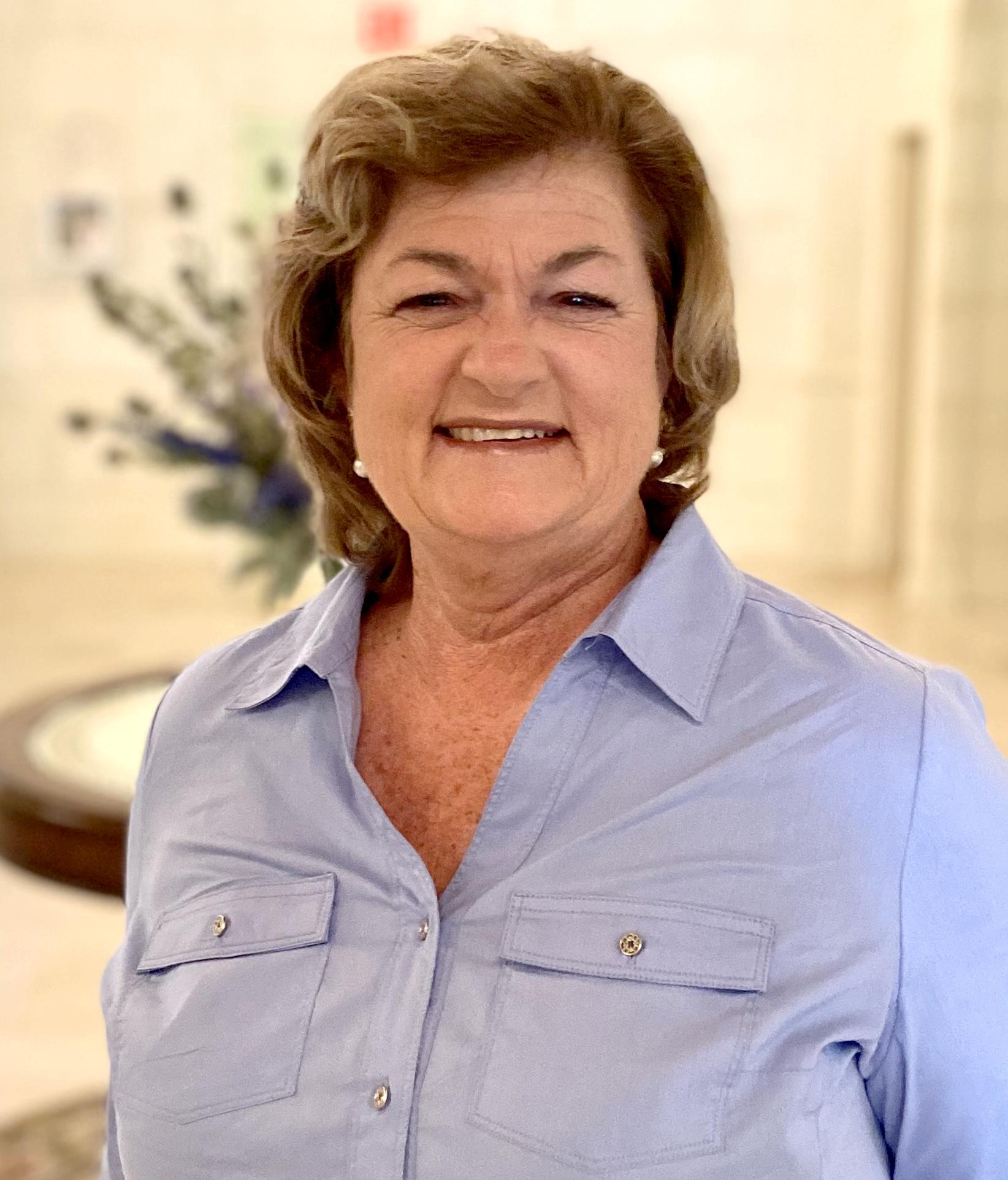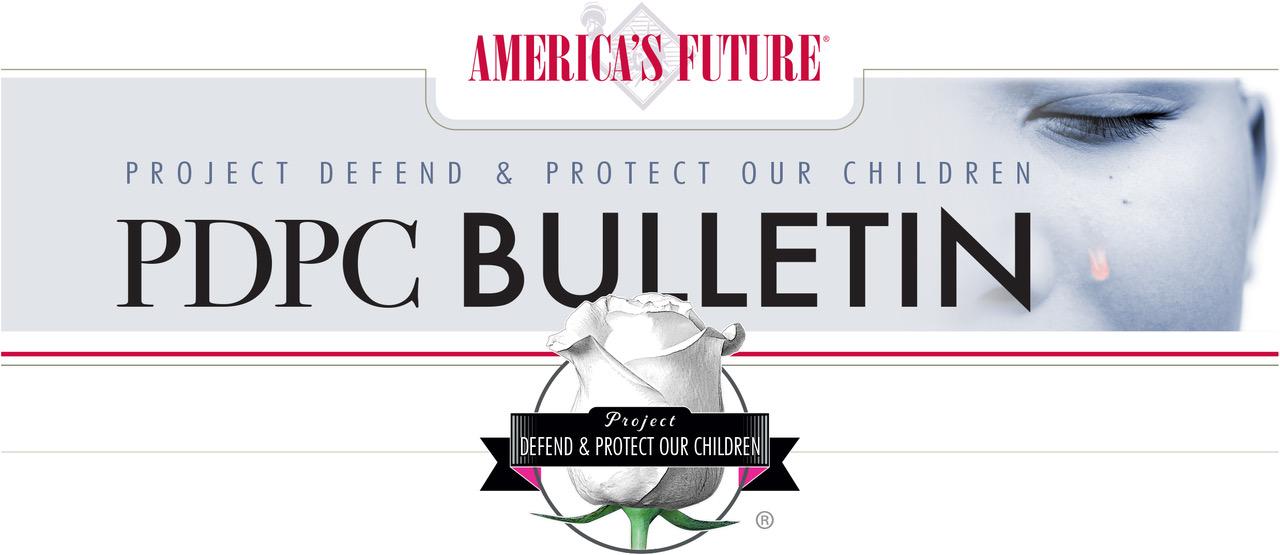
EXECUTIVE DIRECTOR MESSAGE – JUNE 2023
Thanks to all those who have joined America’s Future PDPC network. Every state in the nation is represented, and we are staying connected and sharing information to help end the war on children. In this edition of the PDPC Bulletin, you’ll learn more about the dangers of social media use by teens, and learn about a favorite platform of this age group that has been found to have vast networks of pedophiles. Solutions and preventative tactics are offered to help protect our children online as well. Share them with family and friends. We’re excited about our first Get In The Fight summit and training programs to provide you with the facts and strategies needed to prevent and end child exploitation and trafficking in America. Stay connected with America’s Future for our upcoming announcement about this nationwide campaign, kicking off in Sarasota, Florida, on August 17th. – Mary O’Neill

Children often have secret lives online that can expose them to danger. Not only may they be engaging in online activity that could put them in harm’s way, but your child possibly could have a secret social media account.
There’s a trend on Instagram called Finsta, which is a fake Instagram account. Finsta accounts are popular with teenagers, and often these secret Instagram accounts are created to avoid scrutiny from their parents. Some teens use their secret accounts to post more scandalous and promiscuous content such as sexual photos, drinking, and drug use and to post their participation in risky online challenges.
Here are some tips on how to find out if your child has a secret account.
- Have an honest conversation with your child and ask them straight out if they have a secret account.
- Investigate their account. You can look at your child’s Instagram account and it will show if there is more than one account linked to it. Go to their profile and look next to their name. If you see an arrow pointing downward, click and you should be able to see if they’re logged into any other accounts.
- Pay attention to who they follow. Children with Finsta accounts often follow their own accounts.
Children who frequently use social media sites are more likely to have a slew of problems that’s directly related to their activity on social media. They’re more prone to having online-only friends as opposed to friends in real life. Also, one study revealed that children who use TikTok are developing tic-like attacks – a physical disorder that’s brought on by stress and anxiety. They’re also showing side effects such as increased irritability, increased anxiety and a lack of self-esteem. In worst case scenarios, a child may be interacting with a child sex predator who is grooming them.
CAUTION: WHAT TO LOOK OUT FOR
When a child goes on social media, they’re opening a Pandora’s box that potentially exposes them to these dangers:
- Cyberbullying
- Online predators
- False marketing and scams
- Dangerous viral trends and challenges
- Sharing posts they’ll regret
- Social media addiction
- Unrealistic views of other people’s lives
- Peer pressure
SIGNS YOUR CHILD IS NEGATIVELY IMPACTED BY SOCIAL MEDIA
- Depression
- Anxiety
- Loneliness
- Self-harm
- Addiction
- Fear of missing out (FOMO)
- Negative body image
- Trouble sleeping
- Addiction to social media
SOLUTIONS
The best way to protect children from the dangers of social media is by not allowing them on social media at all. However, if you allow them to have a social media account, many experts advise waiting until they are in the 8th grade.
- Every child is different, so each parent should determine if their child is mature enough to open a social media account. If you’re unsure, you can do a trial run with your child to see how they handle the online world.
- It’s important to educate your child about the dangers online and how to avoid them. Always keep the communication lines open with your child.
- Limit your child’s screen time. The American Academy of Pediatrics recommends a limit of two hours a day for children. It’s also important to make sure your child maintains face-to-face social interactions in real life too and physical activity.
- Monitor your child’s online usage.
A new podcast series called, Not On My Watch, was recently launched as part of America’s Future Project Defend & Protect Our Children (PDPC), to further the effort to educate and raise awareness of the war of children in America. The show is hosted by PDPC Advisor Liz Crokin, an investigative journalist, author, and producer, who is well-known for her persistent effort to expose predators, whether they are individuals or organized enterprises, and end child sex and slave labor trafficking wherever it exists.
In Episode 1 of the podcast, Liz interviews the courageous HHS Whistleblower Tara Lee Rodas, who first exposed government-sponsored, taxpayer-funded child trafficking occurring at the southern border during her testimony at a hearing on April 26, 2023, before the House Judiciary Subcommittee on Immigration Integrity, Security, and Enforcement.
In the interview, Tara describes HHS’s broken system, including the failed policies and inadequate procedures in place purported to handle hundreds of thousands of unaccompanied children entering the U.S. She also explains her skepticism as to the actual number of migrant children missing in America since the Biden administration took over border security, and she urges the public to get involved and speak up. As Ms. Rodas says, “One voice can make a difference.”
America’s Future is pleased to also announce that Tara has joined the PDPC Advisory Board, along with Silvia Almond, who has nearly three decades of dedicated service to helping end human trafficking internationally. To read the bios of members of the PDPC Advisory Board, click here.

Parents are forewarned that Instagram should be considered off-limits to teens as new revelations exposed that the platform hosts a vast network of pedophiles searching for their next target.
In a Wall Street Journal (WSJ) investigation, Instagram – a top social media platform used by teens – was found to not only host the network of pedophiles but acts as a guide connecting perverts with accounts through algorithms to sellers of child-sex materials and hashtags like #pedowhore and #preteensex. The investigation, conducted with researchers at Stanford University and the University of Massachusetts Amherst, further reports that some of these accounts often claim to be run by the children themselves and openly use blatant sexual handles such as “little slut for you.”
Moreover, the researchers found that Instagram accounts offering to sell illicit child sex material usually post “menus” of content. Some of these accounts invite buyers to commission specific acts and may include prices for videos of children harming themselves and “imagery of the minor performing sexual acts with animals,” the researchers at the Stanford Internet Observatory found. Shockingly, some of these accounts also offer children for in-person “meet ups.”
The report also claimed the pedophile accounts on Instagram “mix brazenness with superficial efforts to veil their activity.” Certain emojis function as pedophile code, such as an image of a map—shorthand for “minor-attracted person”—or one of “cheese pizza,” which has been defined as “child pornography.” This contradicts multiple reports from the mainstream media over the years claiming that “pizza” or “cheese pizza” is not a pedophile code word. You can learn more about how child sex predators have used “pizza” as a pedophile code word for years here, and how law enforcement has been able to identify and arrest child predators for using “pizza” as a pedophile code word.

Social media challenges are very trendy and popular, especially with teenagers. A challenge generally involves a user doing a task on video, posting it, and encouraging or daring others to do it too. Even though some challenges are easy, fun, and often silly, there’s usually an element of risk; other challenges are extremely dangerous and may even lead to death. Here are some recent stories on hazardous social media challenges that have cost the lives of children. These stories are difficult to learn about; however, it’s vital for parents to educate themselves on these dangers so they can protect their children.
Chroming
A 13-year-old Australian girl died in April after trying a social media trend called chroming. This involves inhaling toxic substances such as metallic paints, solvents, petrol, and chemicals from aerosol cans for a quick high. Esra Haynes pursued the challenge at a sleepover by inhaling from a deodorant can. Haynes went into cardiac arrest and was on life support for eight days when doctors concluded her brain was beyond repair. Her family then made the heartbreaking decision to turn off the life support machines. Two other teenagers died, and another one suffered brain damage from participating in the same challenge in Australia alone since 2019. Reports of chroming first popped up in 2009, and the trend has reemerged again recently on TikTok.
The Benadryl Challenge
A 13-year-old Ohio boy died in April after participating in a similar trend on TikTok called the Benadryl challenge. This challenge involves popping Benadryl pills to induce hallucinations and goes back to 2020. Jacob Stevens ingested 12 to 14 pills of the over-the-counter antihistamine as his friends filmed him. Stevens began suffering seizures and found himself hospitalized. He was on a ventilator for days before passing away. Other children have died from doing this same challenge including a 15-year-old girl from Oklahoma who passed away in 2020.
The Blackout Challenge
A 16-year-old girl in France died in May after attempting a variation of the Blackout challenge that reportedly went viral as the scarf game. Christy Gassaille died at home attempting the stunt which involves tying a scarf around the neck to asphyxiate oneself until passing out. The Blackout challenge has been one of the most dangerous and deadly challenges to hit TikTok. It’s also been known as the “choking challenge,” or the pass-out challenge where users are encouraged to hold their breath until they pass out. This challenge first emerged in 2008 and the CDC linked it to the deaths of 82 children, at that time. A form of this challenge has made the rounds again starting in 2021 and over a dozen more deaths have been linked to it since.
Here are other dangerous, yet popular social media challenges parents need to be aware of.
- The ice and salt challenge: This entails pouring salt on your skin and placing ice on top to see how long you can stand the burning sensation it causes. This can cause second- and third-degree injuries similar to frostbite, or sores and leave permanent scars.
- The fire challenge: This involves dousing a body part with a flammable liquid and lighting it on fire. This challenge has caused multiple deaths and can leave permanent scars and injuries.
- The Tide Pod challenge: This challenge involves users eating Tide Pods. The laundry detergent has toxic chemicals that can kill you.
- The milk crate challenge: This challenge involves stacking milk crates and balancing on them. This challenge can lead to scrapes, cuts, bruises, broken bones and possibly head trauma.
The best way to protect your children from these challenges is by keeping them off social media. If your children are on social media, educate them on the dangers of challenges like these and forbid them from participating in any of them. It’s important to keep an open dialogue with your child on all the risks social media presents to them and to closely monitor their usage.

America’s Future Project Defend & Protect Our Children Little Flower Advisory Board have dedicated their lives to educating, helping, and inspiring others through their professional work and personal lives. As a unified team of experts and leaders of this important Project, they have pledged their time and talent to the future of America – our precious children. Our Executive Director Mary O’Neill and Board Chair General Mike Flynn lead the advisory team that includes Board member Lara Logan, Liz Crokin, Mike Smith, Lynz Piper-Loomer, Bazell and Tina Baz, Brian Gamble, Tara Lee Rodas, Silvia Almond, and Attorneys Alicia Kutzer, Ben Moore, and Bill Olson.
In this edition of the Bulletin, our PDPC advisors open their notebooks to share their “reader’s choice” selections to watch, read, listen to, and learn more about why it is critical for all Americans to stay informed and get involved in eradicating child exploitation, abuse, and trafficking in America and worldwide.
Sound of Freedom, a true story that exposes the dark world of child trafficking starring Jim Caviezel. It’s based on a federal agent who saves a boy from traffickers while his sister remains in captivity. The agent pursues a high-risk and potentially fatal mission to free her from a fate worse than death. Sound of Freedom hits theaters on July 4. Click here to buy tickets now and view the movie trailer.
Winning Position: The legal team of Vermont’s Allen family called its win a “resounding victory” for First Amendment rights when the state’s Orange Southwest School District Board settled with the family after father, Travis, a middle school soccer coach, and his daughter, Blake, were both disciplined after “expressing their view on a matter of profound public concern: whether a teenage male who ‘identifies’ as female should be permitted to change in a girls’ locker room, regardless of the discomfort experienced by the girls in that room.” To read more about this case, click here.
Raising Awareness: Connecting with communities to raise awareness to help end the war on children and protect their rights is a primary objective of the PDPC initiative. Watch Mary O’Neill, Executive Director of America’s Future, give remarks at last month’s skip-a-thon in Florida to support aftercare restorative programs for survivors of child sex slavery and sexual exploitation.

SPREAD THE WORD: Share the PDPC Bulletin with family members, friends, and neighbors to help raise awareness about how to prevent child exploitation and trafficking in Americans. Encourage others to join the PDPC network to expand the grassroots community-based network of patriot Americans to help end the war on children. And visit the Project’s web page here to watch the latest interviews with America’s Future leadership and our PDPC advisors.
SOMETHING FOR EVERYONE: Help support the PDPC initiative by shopping online in the AF Store. Check out the assortment of Project Defend & Protect Our Children tees for the whole family, and a wide range of accessories like coffee mugs and totes. Thank you for your support!
If anyone causes one of these little ones—those who believe in me—to stumble, it would be better for them to have a large millstone hung around their neck and to be drowned in the depths of the sea. – Matthew 18:6
AMERICA’S FUTURE, INC. IS A FLORIDA NON PROFIT 501(C)(3) TAX-EXEMPT EDUCATIONAL ORGANIZATION. ALL DONATIONS ARE TAX DEDUCTIBLE TO THE FULL EXTENT OF THE LAW. A COPY OF THE OFFICIAL REGISTRATION AND FINANCIAL INFORMATION MAY BE OBTAINED FROM THE DIVISION OF CONSUMER SERVICES BY CALLING TOLL-FREE, WITHIN THE STATE, 1-800-435-7352, OR VISITING WWW.FLORIDACONSUMERHELP.COM. REGISTRATION DOES NOT IMPLY ENDORSEMENT, APPROVAL, OR RECOMMENDATION BY THE STATE. AMERICA’S FUTURE, INC.’S REGISTRATION NUMBER IS CH67839.
© 2023 AMERICA’S FUTURE, INC. ALL RIGHTS RESERVED
PRIVACY POLICY | TERMS AND CONDITIONS
